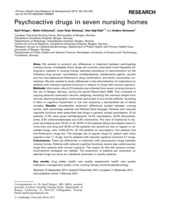Psychoactive drugs in seven nursing homes
Peer reviewed, Journal article
Published version

View/
Date
2012-07Metadata
Show full item recordCollections
Original version
https://doi.org/10.1017/s1463423611000685Abstract
Aims: We wanted to pinpoint any differences in treatment between participating nursing homes, investigate which drugs are currently prescribed most frequently for long-term patients in nursing homes, estimate prevalence of administration for the following drug groups: neuroleptics, antidepressants, antidementia agents, opioids and the neuroleptics/anti-Parkinson’s drug combination, and study comorbidity correlations. We also wanted to study differences in the administration of medications to patients with reduced cognitive functions in relation to those with normal cognition. Methods: Information about 513 patients was collected from seven nursing homes in the city of Bergen, Norway, during the period March–April 2008. This consisted of copying personal medication records, weighing, recording the previous weight from records, electrocardiography, anamnestic particulars of any stroke suffered, recording if there is cognitive impairment or not and analyzing a standardized set of blood samples. Results: Considerable treatment differences existed between nursing homes, both percentage patients and Defined Daily Dosages. Patients with reduced cognitive functions were prescribed less drugs in general, except neuroleptics. Of all patients, 41.5% were given antidepressants, 24.4% neuroleptics, 22.0% benzodiazepines, 8.0% anticholinesterases and 5.0% memantine. The ratio of traditional to atypical neuroleptics was 122:23. In all, 30.0% of the patients taking neuroleptics were on more than one drug and 35.0% of the patients had opioids by way of regular or asneeded drugs, ratio 14.6%:28.7%. Of 146 patients on neuroleptics, five patients had anti-Parkinson’s drugs too. The average use of regular drugs for patient with intact cognition was 7.1 drugs, and for patients with reduced cognitive functions 5.7 drugs. Conclusions: There are differences in treatment with psychoactive drugs between nursing homes. Patients with reduced cognitive functions receive less cardiovascular drugs than patients with normal cognition. The reason for this still remains unclear. Improvement strategies are needed. The proportion of patients per institution on selected drugs can serve as a feedback parameter in quality systems.